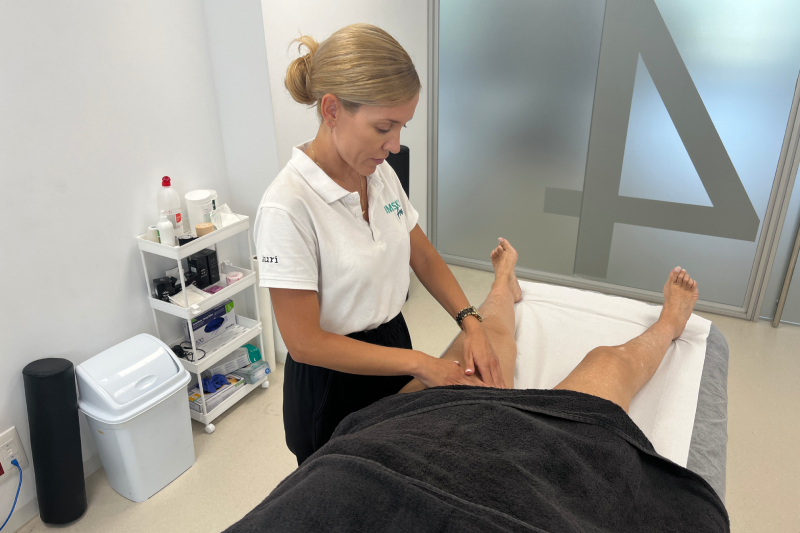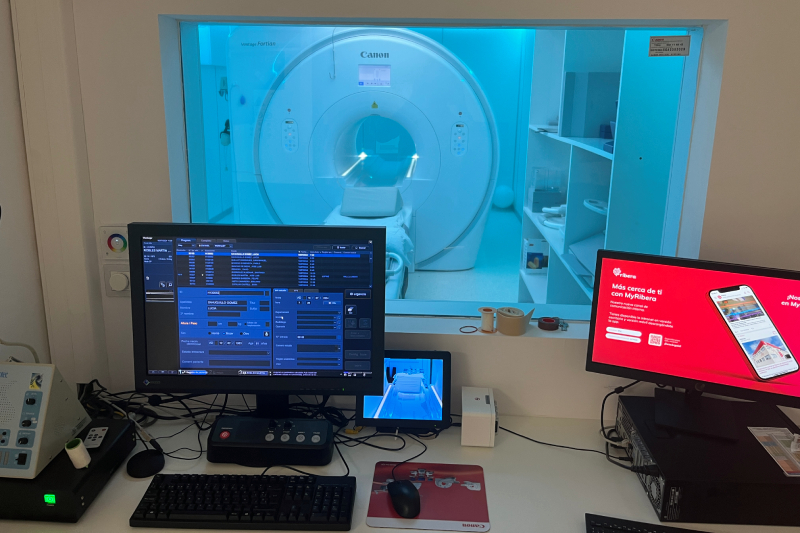
by mgisbert | Aug 29, 2024 | Ribera |
- Oncological physiotherapy improves the quality of life of people undergoing treatment or recovering from surgery: it facilitates pain relief, increases mobility and reduces fatigue.
- The new specialist at the health centre specialising in musculoskeletal pathologies explains the benefits of the therapy to recover muscle mass, which she recommends starting “as soon as possible”.
The Ribera IMSKE hospital has expanded its physiotherapy service with a specialist in oncological physiotherapy, Isabel Gay Fernandez de Córdova, who helps these patients to recover muscle mass, mobility and general physical fitness, which results in an improvement in their quality of life and mood.
“Physical rehabilitation is very important during and after cancer, both in cases where there is surgery and in cases where there is not, because in general, patients move less, their muscles atrophy and they lose weight,” explains the specialist, who recommends starting oncological physiotherapy routines “as soon as possible”. “Even if the patient is receiving chemotherapy, we adapt the guidelines to the needs of each patient and physical exercise has been confirmed as very positive in all cases,” she adds. Other benefits include pain relief (because it boosts the endocannabinoid system), reduction of fatigue and muscle loss (sarcopenia), as well as other side effects of chemotherapy or hormone treatment, such as nausea. It also reduces the risk of osteoporosis and venous thrombosis and, in general, improves the quality of life, well-being and independence of cancer patients, which contributes to increased self-esteem and social relationships. “When the patient feels stronger, feels better physically and is more willing to do things,” says the physiotherapist.
Different studies have also shown that in chemotherapy treatments, there are very positive results in patients who carry out scheduled therapeutic exercise of medium intensity, with less toxicity and greater effectiveness in the treatment itself. “Cancer cells feed on little oxygen. That is why the more time an oncology patient spends on the couch, the worse it is. And with sport, you oxygenate the cells,” he explains. Specifically, specialists recommend doing strength exercises (for example, with weights or rubber bands) and combining it with aerobic exercise (walking, cycling or swimming) and stretching. The Ribera IMSKE hospital has 1,350 square metres dedicated exclusively to patient rehabilitation, as well as a hydrotherapy pool of 45 square metres and three levels of depth.
Isabel Gay Fernandez de Cordova explains that she often works with patients with limpedema, lymphoedema and pathologies related to the lymphatic system, but also with patients who have undergone surgery and need to recover all or part of their reduced or lost mobility due to rest or the surgery itself. “Thanks to the facilities and the super-specialisation of the professionals in the different areas of this hospital, at Ribera IMSKE we can carry out very specific routines that are impossible to do in other health centres,” explains Isabel. The oncology physiotherapist works in coordination with the team of nutritionists and rehabilitation doctors to offer comprehensive care to these patients.

by mgisbert | Aug 22, 2024 | Ribera |
- The health centre specialising in musculoskeletal pathologies has a robotised X-ray room, a high-definition ultrasound scanner, a multi-slice CT scanner, dual energy densitometry (DEXA) and two MRIs of 1.5 and 3 teslas.
- Ribera IMSKE’s Radiodiagnosis Service is committed to personalised and highly specialised medicine in the prevention, diagnosis and treatment of injuries to the locomotor system.
The Ribera IMSKE hospital has incorporated a new high-end 1.5 tesla MRI scanner in its Radiology area, in addition to the 3 tesla MRI already in use at the hospital. In addition, the hospital now has a dual energy densitometry (DEXA), which in addition to bone mineral density, allows the measurement of body mass index and body fat. In this way, as Dr. Eva Llopis, head of Radiodiagnosis, explains, “we can offer patients personalised and highly specialised medicine, with the best technology for the prevention, diagnosis and treatment of injuries to the locomotor system”.
The Ribera Group’s health centre in Valencia, which specialises in musculoskeletal pathologies, has a robotised X-ray room, a high-definition ultrasound scanner and a multislice CT scanner, in addition to the two MRI scans and densitometry mentioned above. With regard to the two MRI scans available at Ribera IMSKE, the head of the Radiodiagnosis service explains that the difference between the two lies in the size of the magnetic field (1.5 or 3 teslas, the unit of magnetic field in the International System), which allows the technology to be adapted to the needs of each patient. “The larger the magnetic field, the more complex the sequences are and the more precision it offers. But at the same time, the more sensitive it is to any metal parts or small shrapnel, as well as to the patient’s movement,” he says. That is why, he adds, “one or the other is not better, it depends on the patient’s needs”. For example, he explains, to check a knee or hip prosthesis, the image quality of the 1.5 tesla MRI is better.
Another of the additions to the Radiodiagnostic Service of the Ribera IMSKE hospital is dual energy densitometry (DEXA), an equipment that has evolved a lot in recent years. In fact, it emerged as a tool for measuring bone mineral density and for diagnosing and monitoring pathologies such as osteoporosis, which reduces bone mass density and is the cause of many fractures in the elderly. Furthermore, it has been considered by the World Health Organisation (WHO) as the great epidemic in developed countries.
The Ribera IMSKE DEXA densitometry model allows, in addition to measuring bone mineral density, to determine the body mass index and fat distribution, both considered risk factors in serious diseases such as obesity or cardiovascular pathologies, while assessing and controlling changes in muscle mass or lean/fat mass in different areas of the body, associated with physical exercise, rehabilitation or sports training.
The information provided by this densitometry is of great practical value for monitoring and optimising, for example, an athlete’s training plan to achieve maximum performance. It also contributes to a complete evaluation of the patient and helps healthcare professionals to monitor the evolution of the established treatment or therapy, diet and/or exercise with objective and complete information.

by mgisbert | Aug 9, 2024 | Ribera |
- The healthcare group highlights the 13% reduction in its carbon footprint and the use of more than 80% of electricity in its centres from 100% renewable sources, as well as the development of the Ribera Life programme to care for the physical and emotional health of its professionals.
- The document, already published on its website, sets out its commitment to growth and diversification in the past year, as well as the main healthcare and research milestones, investment in technology and innovation, its plans for humanisation and healthcare activity, among others.
The healthcare group Ribera has just published its Sustainability Report for the 2023 financial year, in which it highlights, among other things, the important advances achieved in its environmental policy, internal social benefits, governance policy, growth and diversification, main healthcare and research milestones, its commitment to technology and innovation, as well as the major figures of its recent activity.
Ribera is aware that sustainable development is linked to environmental protection and pollution prevention, so it has an Environmental Policy that is applied in all its areas, and which promotes initiatives and technologies that encourage more sustainable practices. These actions include the installation of photovoltaic solar panels, the implementation of devices to reduce energy consumption, the updating of equipment to improve its efficiency, and the training of professionals in the efficient management of resources, among other measures. Thus, by 2023, more than 80% of the electricity consumed will be of 100% renewable origin and its carbon footprint will have been reduced by 13%. In addition, last year a corporate sustainability manager was appointed and the group’s Sustainability Committee was set up.
With regard to social issues, Ribera once again opted for a people management policy that prioritises the well-being of its professionals. For Elisa Tarazona, CEO of the healthcare group, “we need to count on healthcare professionals, facilitate their continuous training and personalise working conditions with flexibility to attract and retain talent”.
Its Sustainability Report highlights the Ribera Life programme, which reflects Ribera’s integral commitment to its employees, thus contributing to an organisational culture that improves the quality of life of its professionals and generates a working environment in which they feel valued and happier. To achieve this well-being, the group works on different initiatives under five dimensions: physical and emotional health, professional health, financial health, team health and social health.
Among other milestones, the number of permanent contracts grew by 5% and by the end of 2023, nearly 90% of the group’s professionals had this type of contract. Work-life balance, diversity, equality policies and training are very important aspects in the management of people in the healthcare group: flexibility, adaptation of working hours and reduction of working hours, multiculturalism (there are professionals of more than 59 nationalities), equality (the number of female managers has increased by more than 12% compared to 2022 and the number of female professionals now accounts for 72% of the group) and training hours, which have increased by more than 18% compared to the previous year, with special programmes on the prevention of harassment and gender-based violence. For all these reasons, the healthcare group has once again entered the ranking of the 100 best companies to work for in Spain, published annually by a specialised media.
The Ribera Group’s Sustainability Report also lists its main operations and results, highlighting the incorporation of the Cascais Hospital, the group’s first healthcare centre in Portugal, the Cardiosalus group of clinics in Murcia and the Ciudad Quesada clinic in the Torrevieja area. It also highlights the more than 25 million invested last year in technology and infrastructure, as well as the strategic agreement signed with Microsoft to promote innovation and artificial intelligence, and the implementation of new CAT scans and magnetic resonance imaging in several hospitals, as well as healthcare and research milestones with the expansion of healthcare services in its hospitals in Galicia and Murcia, the internal assumption by Ribera Lab of the management of the integral biological diagnosis of the Vinalopó and Torrejón areas and the opening of a new psychiatric hospitalisation plant at the University Hospital of Torrejón, among others.
The healthcare group also highlights in its annual report the implementation of outstanding actions by the Ribera Salud Foundation to promote healthcare research and the launch of the Innovation Health Center at the Cascais Hospital, as well as the numerous awards received throughout the year.
In terms of humanisation and patient experience, once again this year the meetings of the patient advisory councils in most of the Ribera centres to listen to and attend to their needs, the remodelling of spaces and initiatives such as the outdoor walks for ICU patients and the Ritmos de Vida programme, which combines music and health, stand out.
Special mention should be made of the health promotion plan and collaboration with entities, which organised more than 200 activities last year, with workshops, conferences and exhibitions, the celebration of world days and the publication of informative material. The RDV campaign, with the manufacture of the first arrhythmic metronome to prevent cardiovascular diseases, toured the Group’s main hospitals, and the 7th edition of the Cervantes Route at the University Hospital of Torrejón brought together thousands of walkers along the Henares Corridor, promoting healthy lifestyles. Group professionals have participated in this programme as a corporate volunteering activity, as well as with the Discamino Association, which helps people with disabilities to walk the Camino de Santiago, and with Casa Caridad and Vida Digna, among other entities. As Elisa Tarazona points out, “we are committed to health promotion and disease prevention as an essential aspect of our sustainability policy in order to address health in all its aspects in a comprehensive manner”. Consult the Report here.




Recent Comments